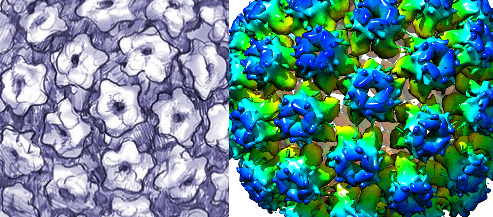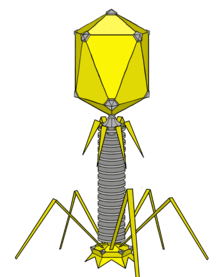Theviral family Papillomaviridae comprises of papillomaviruses (abbreviated as PVs); and they were previously classified together with polyomavirus in the Papovaviridae family which is no longer in use in viral taxonomy for DNA containing viruses. Papillomavirus is the only viral genome in the Papillomaviridae family; and the papillomaviruses are oncogenic i.e. they are cancer-causing viruses. Human papillomavirus (HPV) causes papillomas on the lips as well as on the skin and mucous membranes of infected individuals.
Papillomavirus also causes infection in non-human hosts such as cattle, rabbit, horse, elephant, dog, and birds. Viruses in this family have a circular dsDNA genome that is devoid of envelope. They are icosahedral in shape, and measure about 55 nm in diameter. They are also resistant to ether but sensitive to UV light and formalin. The replication site of viruses in this family is the nucleus of their infected host cell and they are released from the host cells they infect via lysis. Papillomaviruses induce benign lesions of the skin and mucous membranes in individuals infected by the virus.
The lesions produced on the skin are known as warts while lesions produced on the mucous membranes are known as condylomas. Genital warts (with occur on the external genitalia of men and women) and cervical cancer are the two most significant infections caused by the papillomavirus in humans. The papillomaviruses are of immense clinical importance because of their ability to initiate the development of cancer in infected individuals. Some of the cancers associated with the papillomaviruses include cancer of the cervix, mouth, skin, urogenital tract, eye, gastrointestinal tract, and cancer of the eyes.
HPV is implicated clinically as the causative agent of cervical cancer in women, and the virus has a worldwide distribution. Studies have shown that genital HPV infection is one of the world’s most common sexually transmitted viral infections; and the disease occurs in both men and women with varying prevalence’s. Since the contraction of one sexually transmitted disease (STD) in a person can place an individual at a higher risk of acquiring another STD or STD agent, the risk of infection with HPV is also high especially in HIV-infected persons whose immune system have been suppressed by viral infection.
The sexual route is the main route of transmission of the disease but vertical transmission from mother to child especially during delivery and transmission via direct contact with infected materials such as sharp objects can also occur. There is no specific antiviral agent for the treatment of the disease; and the skin lesions are usually self-limiting. Surgery is often considered in some cases of papillomavirus infection especially those infections involving the genitalia.
References
Acheson N.H (2011). Fundamentals of Molecular Virology. Second edition. John Wiley and Sons Limited, West Sussex, United Kingdom.
Alan J. Cann (2005). Principles of Molecular Virology. 4th edition. Elsevier Academic Press, Burlington, MA, USA.
Alberts B, Bray D, Johnson A, Lewis J, Raff M, Roberts K and Walter P (1998). Essential Cell Biology: An Introduction to the Molecular Biology of the Cell. Third edition. Garland Publishing Inc., New York.
Barrett J.T (1998). Microbiology and Immunology Concepts. Philadelphia, PA: Lippincott-Raven Publishers. USA.
Black, J.G. (2008). Microbiology: Principles and Explorations (7th ed.). Hoboken, NJ: J. Wiley & Sons.
Brian W.J Mahy and Mark H.C van Regenmortel (2010). Desk Encyclopedia of Human and Medical Virology. Elsevier Academic Press, San Diego, USA.
Brooks G.F., Butel J.S and Morse S.A (2004). Medical Microbiology, 23rd edition. McGraw Hill Publishers. USA.
Cann A.J (2011). Principles of Molecular Virology. Fifth edition. Academic Press, San Diego, United States.
Carter J and Saunders V (2013). Virology: Principles and Applications. Second edition. Wiley-Blackwell, New Jersey, United States.
Champoux J.J, Neidhardt F.C, Drew W.L and Plorde J.J (2004). Sherris Medical Microbiology: An Introduction to Infectious Diseases. 4th edition. McGraw Hill Companies Inc, USA.
Dimmock N (2015). Introduction to Modern Virology. Seventh edition. Wiley-Blackwell, New Jersey, United States.
Dimmock N.J, Easton A.J and Leppard K.N (2001). Introduction to modern virology. 5th edition. Blackwell Science publishers. Oxford, UK.
Discover more from #1 Microbiology Resource Hub
Subscribe to get the latest posts to your email.



